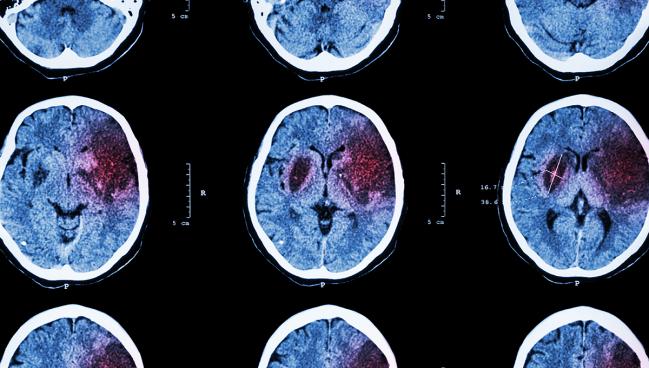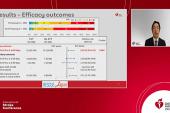Endovascular Therapy Works for Ischemic Strokes With Large Cores, Trials Affirm
After this, “it will be unethical to continue to randomize patients with large strokes to medical therapy,” says Pierre Fayad.

Though currently excluded from guideline recommendations for endovascular stroke therapy, patients with acute ischemic strokes with large infarct volumes derive benefits from such treatment, results of two randomized trials confirm.
In both the SELECT2 and ANGEL-ASPECT trials, which enrolled patients who had large cores on imaging up to 24 hours after stroke onset, adding thrombectomy to medical therapy improved 90-day functional outcomes over medical therapy alone, with acceptable safety, researchers reported last week at the International Stroke Conference in Dallas, TX.
The findings, published simultaneously online as separate papers in the New England Journal of Medicine, are consistent with those of the RESCUE-Japan LIMIT trial released a year ago and extend the demonstrated benefits of endovascular stroke therapy to people living in different parts of the world.
Addressing all three trials, Pierre Fayad, MD (University of Nebraska Medical Center, Omaha), who wrote an accompanying editorial in NEJM, said, “They’re all about the same when it comes to the outcomes and to the risks, in spite of differences in population, healthcare systems, and different IV tPA doses.”
To TCTMD, Fayad said that the initial trials establishing thrombectomy as the standard of care to prevent disability in patients with strokes caused by large-vessel occlusions excluded those with large ischemic cores on imaging, and those selection criteria are reflected in guideline recommendations.
Now, positive data from all three trials are likely to change clinical practice and, eventually, official guidance, Fayad said.
“The experience at this point is quite extensive and the results are impressive,” he said. There are still ongoing trials exploring the impact of thrombectomy in patients with large infarct volumes, he pointed out, but added, “I think it will be unethical to continue to randomize patients with large strokes to medical therapy based on these results.”
With the accumulated trial evidence, “at this point, really there is no patient that comes in within 24 hours that shouldn’t receive thrombectomy if they are eligible,” he said, noting that the decision should be made not based on the size of the infarct, but on other factors like bleeding risk and additional health issues.
ANGEL-ASPECT
Zhongrong Miao, MD (Beijing Tiantan Hospital, China), presented the results of the ANGEL-ASPECT trial, which was conducted at 46 centers across 20 Chinese provinces. It was stopped early after an interim analysis demonstrated the positive effects of endovascular therapy.
Investigators randomized 456 patients with a large-vessel occlusion in the anterior circulation of the brain and noncontrast CT findings indicative of an Alberta Stroke Program Early CT Score (ASPECTS) of 3 to 5 with any infarct volume, or an ASPECT of 0 to 2 and an infarct volume of 70 to 100 mL.
Median patient age was approximately 67.5 years, and most participants (61%) were men. Median ASPECTS was 3 and the median infarct core was 61 mL in the thrombectomy arm and 63 in the control arm. IV thrombolytics were administered in 28% of cases. The median time to treatment was about 7.5 hours in each group, with more than 60% treated beyond 6 hours.
For the primary outcome, there was a positive shift in modified Rankin Scale (mRS) scores at 90 days when thrombectomy was used (generalized OR 1.37; 95% CI 1.1-1.69). Those who underwent the procedure also were more likely to be functionally independent (mRS 0 to 2) and capable of ambulating independently (mRS 0 to 3) at 90 days.
In terms of safety, there were numerically higher rates of symptomatic intracranial hemorrhage (ICH) at 48 hours (6.1% vs 2.7%; P = 0.12) and decompressive hemicraniectomy during hospitalization (7.4% vs 3.6%; P = 0.15) in the intervention arm, with significantly more overall ICH (49.1% vs 17.3%; P < 0.001).
The SELECT2 Trial
Results of the SELECT2 trial, presented next by Amrou Sarraj, MD (University Hospitals Cleveland Medical Center – Case Western Reserve University, OH), were largely consistent with the ANGEL-ASPECT findings.
The trial, conducted at 31 sites in the United States, Canada, Europe, Australia, and New Zealand, also was stopped early after the data and safety monitoring board requested a review following the release of the RESCUE-Japan LIMIT trial. SELECT2 ultimately randomized 352 patients based on a noncontrast CT ASPECTS of 3 to 5 and/or a core volume of at least 50 mL on CT perfusion or diffusion-weighted MRI. Median patient age was roughly 66.5 years, and most participants (59%) were men.
IV thrombolytics were administered in 19% of cases. The estimated ischemic core volume was 79 mL in the control arm and 82 mL in the thrombectomy arm. Median ASPECTS was 4. Randomization occurred a median of 9.1 to 9.8 hours after the time the patients were last known to be well.
As in ANGEL-ASPECT, there was a significant shift in 90-day mRS scores favoring thrombectomy (generalized OR 1.51; 95% CI 1.20-1.89), with a number needed to treat of about 5. The investigators calculated a 60% probability that patients treated with endovascular therapy would have better functional outcomes than those treated with medical therapy alone. The findings were consistent across subgroups and in as-treated and per-protocol analyses.
Thrombectomy was associated with increased rates of functional independence and independent ambulation.
Symptomatic ICH was infrequent overall and not different between the thrombectomy and control groups (0.6% vs 1.1%). The mortality rate did not differ either (38% vs 42%), but early neurological worsening was more frequent after thrombectomy (25% vs 16%; RR 1.59; 95% CI 1.03-2.45). Sarraj said, however, that that did not take away from the overall benefit tied to the procedure.
Thrombectomy provided substantial reperfusion in 80% of patients. There were some complications, including arterial access-site occlusion in three patients and hematoma and infection in one patient each. In terms of vascular injury, vasospasm occurred in 6.2%, dissection in 5.6%, perforation in 3.9%, and “other” in 1.1%.
“In conjunction with the RESCUE-Japan LIMIT and ANGEL-ASPECT trials, these results show unequivocal evidence that thrombectomy is superior to medical management in patients with large core,” Sarraj concluded.
Todd Neale is the Associate News Editor for TCTMD and a Senior Medical Journalist. He got his start in journalism at …
Read Full BioSources
Sarraj A, Hassan AE, Abraham MG, et al. Trial of endovascular thrombectomy for large ischemic strokes. N Engl J Med. 2023;Epub ahead of print.
Huo X, Ma G, Tong X, et al. Trial of endovascular therapy for acute ischemic stroke with large infarct. N Engl J Med. 2023;Epub ahead of print.
Fayad P. Improved prospects for thrombectomy in large ischemic stroke. N Engl J Med. 2023;Epub ahead of print.
Disclosures
- SELECT2 was supported by an investigator-initiated grant from Stryker Neurovascular to University Hospitals Cleveland Medical Center and the University of Texas McGovern Medical School.
- ANGEL-ASPECT was supported by unrestricted grants from Covidien Healthcare International Trading (Shanghai), Johnson & Johnson MedTech, Genesis MedTech (Shanghai), and Shanghai HeartCare Medical Technology.
- Sarraj reports consulting for AstraZeneca and consulting for, receiving grants/contracts from, and serving on the speakers bureau and advisory board for Stryker.
- Fayad reports personal fees for serving on clinical events committees for Medtronic and for serving on a data and safety monitoring committee and for performing grant application review for the National Institute of Neurological Disorders and Stroke.
- Miao reports no relevant conflicts of interest.





Comments